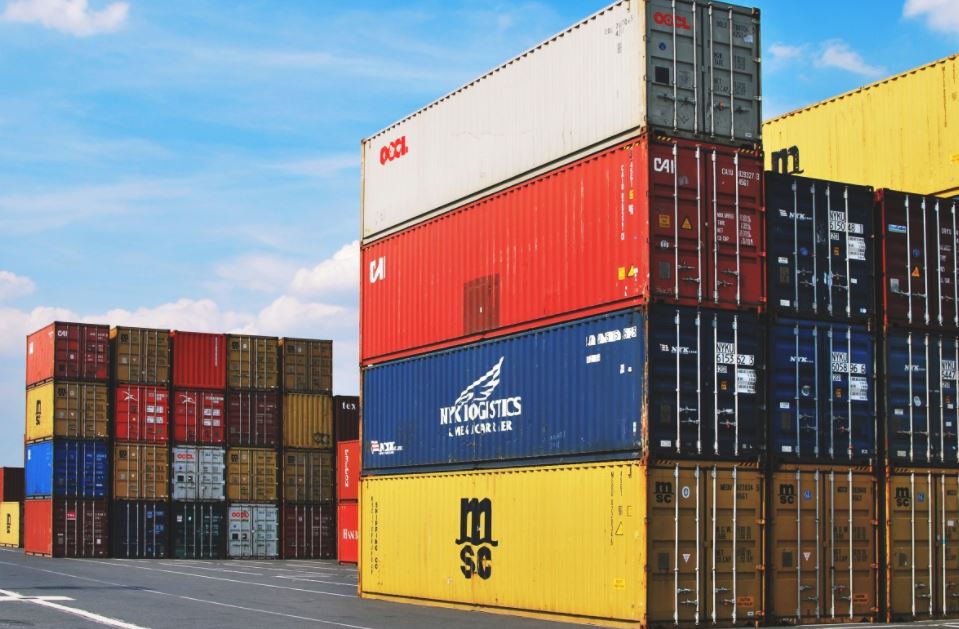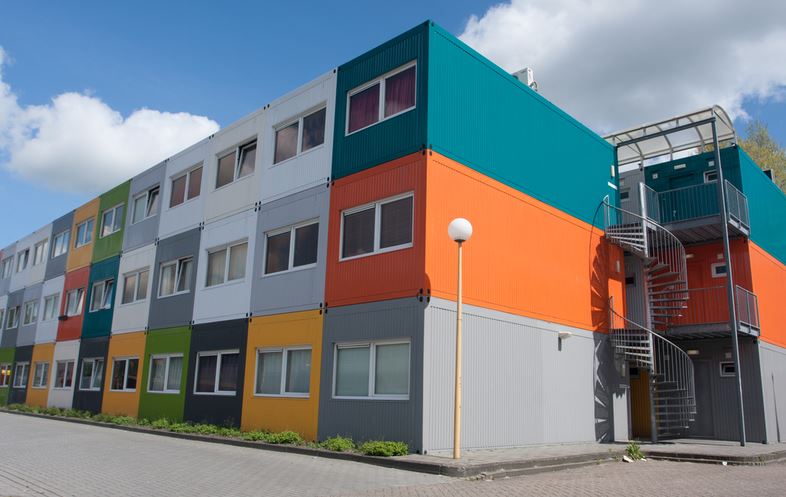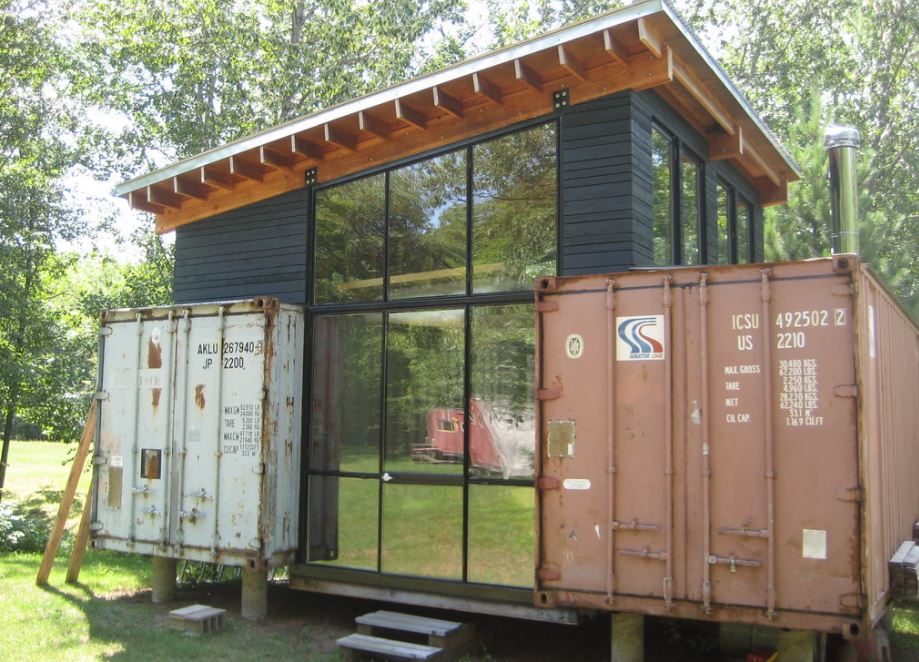Shipping containers have been used at seaports for decades. They usually get stacked on top of each other to conserve space. Each container holds a massive quantity of consumer products as part of a logistical operation. Companies and manufacturers rely on shipping containers to transport their products fast and efficiently.
It wasn’t that long ago when shipping containers did not even exist. We take them for granted now, but there was a time when it was more difficult to send large shipments of products. But a series of innovators figured out a way to conquer this problem by creating shipping containers of various sizes and shapes. These inventions ended up changing the global economy forever.
Have you ever wondered what individuals and companies used to transport items before shipping containers were around? Let’s explore the history of shipping containers and how they evolved in our world.

The Pre-History of Shipping Containers
Human beings have done amazing things over the last few hundred years. They’ve sailed across the globe without knowing what they would find on the other side. The inventory on their ships consisted of treasures, tools, cotton, food and water.
Most civilisations at the time had never seen all of these things together before. Only the Romans, Greeks, Egyptians and eventually the British had this luxury. The British only started sailing the seas about 500 years ago, but the Romans, Greeks, and Egyptians started thousands of years ago. Shipping containers did not exist back then, so what did they use on the boats to store their food and supplies?
Port warehouses were used to store goods until an empty ship arrived to transport them. Some of the primitive types of transport containers used were barrels, crates, sacks, and bales. One ship had enough room to store about 200,000 cargo pieces, whether it be barrels, sacks, bales, crates or a combination of them. There were no forklifts or machines to help people lift these containers onto the ships. Everything had to be loaded onto the ships by hand. This required a lot of energy and strength. It was very exhausting work.
The Second Industrial Revolution took place in the early 1900s. Trains were now used to transport cargo across the country. But it was still a challenge to get the cargo off the ships and transported to the trains. The process was relatively slow, and shipping delays were very common. Sometimes it would take up to a week to unload the cargo from a large ship. The fact that trains existed didn’t change how slow it was to load and unload them.
Malcolm McLean: The Man Who Standardised the Transportation of Goods
There was still no standardised method of transporting goods in the early 20th century. Transportation continued to be slow because the trucks, trains, ports, and ships were not coordinating properly. It took the creativity and inventiveness of a man named Malcolm McLean to turn this all around.
Born in 1914, McLean was raised on a North Carolina farm in the United States. He graduated from grade school when he was 17 years old. After graduation, he spent the next three years working and saving money until he could afford to buy a second-hand truck. He used this truck to start his own transport business in 1934.
It didn’t take long for his business to take off. McLean found himself buying five more trucks to accommodate the growing demand for his transport services. However, he didn’t like how slow the dockworkers would be at loading and unloading the cargo items from the boats. He felt they were slowing him down because he had to wait hours for them to finish.
McLean continued to grow his business between 1937 and 1950. He ended up with more than 1,750 cargo trucks and approximately 37 different shipping terminals. His company had become the fifth-biggest truck-based transportation business in the United States. But his business would face new setbacks after the government started imposing fees and weight restrictions on ground transport vehicles. The drivers of his trucks were forced to pay fines because of the heavy cargo they were hauling.
McLean needed to come up with a better way to transport cargo without being fined so much. One idea he thought about for many years was the use of several regular-sized trailers on boats. Normally, his trucks would load and transport a couple of large containers of goods at a time. What he wanted to do now was load hundreds of trailers onto boats instead of relying on trucks. Trucks could still be used to make short distance deliveries from the trucking hubs, but it would allow them to circumvent the truck stops and the weight fees on the interstate.

McLean Brings the Idea to Life
McLean wanted to pursue his idea further and make shipping trailers the standardised method of transporting cargo. So, he sold his road-based cargo transportation business to devote all his attention to this next venture.
In 1955, McLean applied for a bank loan in the amount of $42 million. After the loan was approved, he bought an existing shipping company called “Pan-Atlantic Steamship Company” for $7 million. His interest in the company pertained to the docking rights it owned in several eastern port cities. McLean wanted these docking rights to flesh out his shipping trailer idea.
McLean changed the name of Pan-Atlantic Steamship Company to “SeaLand Industries.” He hired an engineer named Keith Tantlinger to help him design his vision of a new shipping container. The end result was a durable and stackable shipping container that could easily be loaded and unloaded from a ship. The containers were also lockable, making it difficult for thieves to steal items from them.
McLean and Tantlinger filed numerous patents to protect their rights to the container inventions. The next obstacle in McLean’s path was to design a ship with enough weight capacity to store all the stacked containers. He bought an oil tanker because its construction gave it a high weight capacity to transport heavy cargo. McLean had to modify some parts of the ship to fit approximately 58 stackable containers. Meanwhile, the ship was still hauling 15,000 tons of petroleum inside its base.
The name of his ship was called Ideal X. Its design was put to the test on April 26th, 1956, after the Ideal X travelled from New Jersey to Houston. His business received an order to transport cargo from the Houston docks back to New Jersey. The Ideal X successfully transported cargo at a 25% discount from the traditional price. It significantly increased the demand for his cargo transportation services.
After the first successful cargo shipment, McLean had the motivation to purchase a new ship that was designed to haul his stackable containers. He named the boat “Gateway City.” Its first route was from New Jersey to Miami in October 1957. The ship made it so easy to load and unload the cargo containers that only two dockworker teams were needed. They successfully moved the cargo at an impressive rate of 30 tonnes per hour.
Standardisation Method of Shipping Containers
McLean had used 35-foot shipping containers up until this point. There was still no standardised shipping container size yet. If the containers were stacked effectively and efficiently, each container needed to be the same size. This would also allow for better transportation equipment, trains, and trucks to be designed to accommodate this standard size.
Standardised shipping containers did not gain traction until the Vietnam War in the 1960s. The Federal Government needed to develop a way to deliver more goods to its military members in a fast and efficient manner. They realised that standardisation was the only way to make that happen. Since McLean already had a patent for his standardised shipping container invention, he released it to the government. His patent set the standards for the ratings, terminology and dimensions associated with these shipping containers.
The result was a switch from the previous 35-foot shipping containers to 20-foot shipping containers and 40-foot shipping containers. These sizes have been the standardisation for shipping containers ever since.

The Advantages of Shipping Containers
The first international shipment using standardised containers took place in April 1966. SeaLand Industries stacked 236 shipping containers onto their Fairland boat and sailed it to the Netherlands from the United States.
The success of this voyage sparked a huge wave of new container ships sailing the ocean. SeaLand Industries was transporting 27,000 containers on 36 container ships by 1970. The company set up deals with over 30 American ports and numerous international ports. Globalisation exposed after that.
McLean enjoyed the success of his company but soon decided to part ways with it. He sold SeaLand Industries for $160 million to R.J. Reynolds. The company’s new owner continued to expand the operation and made globalisation more common in the modern world.
The standardised shipping containers changed the freight transport industry forever. Cargo shipping costs decreased by over 90%. The loading cost went from $5.86 per ton to $0.16 per ton. By 1983, about 90% of all nations were using these container ports. It was a vast increase from the mere 1% of countries using them in 1966.
In 1970, all shipped cargo was loaded and unloaded at a rate of more than 30 tonnes per hour. It was a massive increase from the 1.3 tons per hour rate that existed before the standardised containers were used. Nowadays, roughly 90% of all the products people purchase were shipped in one of these containers.
When you consider that 20 million standardised shipping containers exist worldwide, it is not too hard to believe that so many products are transported in them. Over 6,000 boats carry standardised shipping containers. They make more than 200 million trips across the ocean each year.
The International Maritime Hall of Fame awarded McLean with the “Man of the Century” honour.
Criticism Toward the Standardised Shipping Container
The standardised shipping containers made a lot of people and businesses very happy. However, the shipping speed and efficiency from these containers did not please everybody. The dockside union workers were upset because there was a decreased demand for dockworkers now.
Before the standardised shipping containers existed, several dockworkers were employed at the ports to physically load and unload goods from the boats. But with the new standardised shipping containers, they don’t require as many dockworkers to handle them. As a result, it eliminated many of the jobs at these ports.
The union workers decided to go on strike in the early 1970s. It was their way of protesting against the use of these shipping containers in the industry. The dispute ultimately ended with companies paying severance to the union workers while the standardised shipping containers continued to get used. The significant cost savings allowed companies to afford to pay severance packages to the workers.
The Trend of Constructing Buildings with Shipping Containers
Shipping containers are not just used for transporting products and items. Someone came up with the brilliant idea of constructing buildings with shipping containers. That might sound like a weird idea, but it actually worked out fine.
This all started in western countries where imports are greater than exports. The United States, for example, receives more imports than any other western country. After the imports arrive in shipping containers, fewer exports are shipped back to other countries. The result is extra shipping containers that are not being used at the ports.
The U.S. Department of Transportation estimates that roughly 17.5 million containers (20 feet each) were imported in 2012, while only 11.9 million were exported. This left ports with a total surplus of over 5 million shipping containers at 20 feet each. The trend really picked up between 2008 and 2012.
Many critics thought the shipping containers could just be recycled or sent back to other countries. They couldn’t be recycled because melting the containers’ steel material would be costly and not very efficient. And if they’re shipped to other countries, it would increase costs as well.
Therefore, new alternative ways to use the shipping containers were developed. The most notable alternative was to convert one or more shipping containers into a liveable building. On November 23rd, 1987, someone by the name of Phillip Clark filed the paperwork for a patent on this idea. The patent outlines and describes how you can put shipping containers onto a weight-bearing foundation to form a liveable building.

Multiple shipping containers could create a modular building, making each container a piece of modular building material. All you have to do is reuse empty shipping containers that would otherwise go to waste. It is a great way to build an affordable home for people.
Clark’s patent was approved on August 8th, 1989, just two years after it was filed. Naturally, everyone wanted to know more about Phillip Clark and how he came up with the idea to transform these shipping containers into modular building materials. Well, the truth is he wasn’t the first person to come up with this idea. Hollywood producers came up with it before him.
During the production of the 1985 movie Space Rage, the crew converted shipping containers into useable buildings on the film set. It was not widely publicised at the time, though. A British architect named Nicholas Lacey also thought of the idea in the 1970s. He wrote a university thesis that discussed the concept of creating habitable dwellings out of used shipping containers. After he graduated from the university, Lacey partnered with Urban Space Management to build several houses out of these shipping containers.
If we keep digging back into the past, we can see that the Insbrandtsen Company Inc. submitted a patent filing for something called the “Combination Shipping Container and Showcase” in 1962. The patent filing showed the inventor was a person named Christopher Betjemann. His idea was for companies to use shipping containers as exhibition booths when showing off their products at trade shows and events.
The Normalisation of Using Shipping Containers to Construct Buildings
An American writer named Steward Brand became the first person to publish literature about using shipping containers to construct buildings. His book entitled “How Buildings Learn” discusses various ideas regarding the concept of creating office space with shipping containers. Many builders liked this idea and started to build homes with shipping containers instead.
The first officially constructed building using shipping containers was called “The Simon’s Town High School Hostel.” After Simon’s Town High School received a donation of 40 reusable shipping containers, the school officials decided to build a hostel using these containers. They wanted the hostel to house up to 120 people whenever they needed shelter. It cost the school approximately $227,000 and finished on November 30th, 1998.

Modern Shipping Container Homes
A Californian architect named Peter DeMaria started designing America’s first shipping container homes in 2006. His first completed shipping container home was called the Redondo Beach House. It met the standards of the National Uniform Building Code after it was finished in 2007.
The success of the project led to the construction of more shipping container homes throughout the world. The most publicised homes include the following:
- The Texan firm “Poteet Architects” created a shipping container guest home in 2010. They used a 40-foot container with 32 sqft of living space.
- In Costa Rica, it is inexpensive to build homes there. It was even more affordable to make “Containers of Hope,” a house comprised of several shipping containers and a sloped roof.
- In Chile, a man named Sebastián Irarrázaval designed this 3,800-square foot home using 12 shipping containers. He chose a nice spot on a hillside to build the home. It is close to Santiago, so the views are outstanding. The home is called “The Caterpillar House.”
If you go on the internet, you can find custom-built shipping container homes for sale. Most of them are built in areas with few building restrictions. You can expect these areas to be out in the woods or someplace away from traditional looking houses. But that’s okay because it only means you get more privacy and better views from your home.
According to online searches, the price range of shipping container homes ranges from $15,000 to $100,000. The biggest expense relates to the land more than anything else. But if you already own the land, you could hire an experienced architect to design you a shipping container home for a reasonable price.
Conclusion
Shipping container homes are only growing in popularity. Since the cost of living increases each year, more people cannot afford traditional housing. Rent prices are skyrocketing for flats and homes. It is also expensive to purchase them too. Because of this, a growing number of people are turning to alternative housing options. Shipping container homes have proven to be a viable option for affordable housing.
That’s not all you can build with shipping containers. Some business people and public officials believe shipping containers can reduce the cost of constructing restaurants, schools, and offices. In another 50 years, we may very well see more shipping container businesses, schools, offices and homes in local communities throughout the globe.
Malcolm McLean and the other inventors could never have imagined how much their ideas would change the world in this way. All they wanted to do was create a profitable idea that would help specific sectors of their industries. Now, it appears like constructing buildings with shipping containers will impact several industries. Perhaps this could help solve the homeless crisis too.